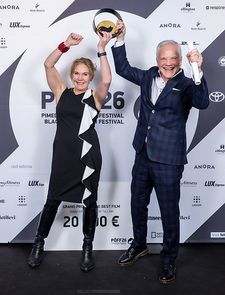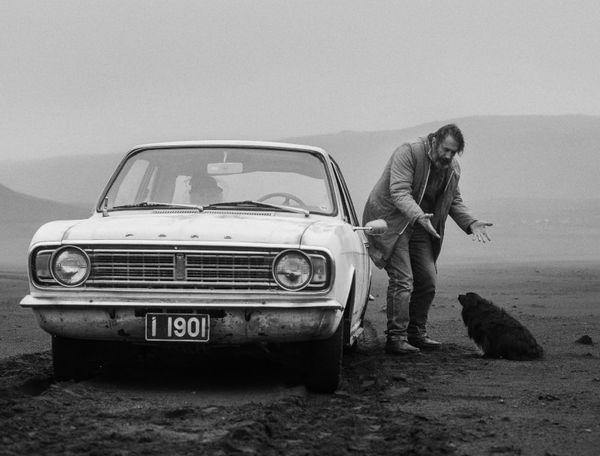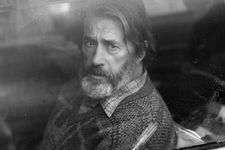 |
| Hlín Jóhannesdóttir and Hilmar Oddsson with the Grand Prix Photo: Courtesy of POFF/Erlend Štaub |
Although the film didn’t happen at that time, Oddsson never forgot about it. “I was always sure one day we would do it,” he says. He also explains why the tone of his film is, in some ways, a tribute to his own dad, playwright Oddur Björnsson.
He adds: “Þröstur was with me more or less all the time. I'm sure that there were times when he was not so sure we would do it as I was. I knew we would because it was too important to me. And the reason why it's important to me is because it’s a very personal film. I don't mean the storyline. This mom figure is certainly not my mother and there is nothing in my life that resembles their lives.
"It's more the way I tell the story. I'm sort of paying respect to my father who was a playwright. He wrote in the style of absurdist theatre, like Samuel Beckett and Ionescu and all those guys. So I was brought up with that kind of storytelling, that strange absurd things can be told in a very natural way. And I never used that childhood background of myself, so I wanted to do it. It has to do with certain kinds of humour, which is pretty black, but it's very subtle. So that's how the story came about. The style? It came to me in black and white. There was no choice for me. I was always joking, I was waiting for somebody to stop me, because producers don't like black and white - but nobody did.”
The director says that casting the role of the mother was also not as hard as he expected it to be - and again harks back to a connection with his dad.
“Kristbjörg Kjeld is the grand old lady of Icelandic films and on stage. She's a huge thing in Iceland, and she was 86 when she did this. She's 87 or 88 now. The reason why she's not here with me in Tallinn is because yesterday, she was doing a performance in the National Theatre in Reykjavik, so couldn't get away from it. So she's still active at that age, and she's one of a kind. She has done a lead in another film of mine, Cold Light. I have known her since I was a kid, that's another thing. So if she could do it, there was no other option for me.”
 |
| Driving Mum. Jon and Bresneff. Hilmar Oddsson on Dreki the dog who plays Bresneff: 'He concentrates and he knows where to put his attention' |
Arguably the absurdist style that informs the film doesn’t just fit with modernist theatre but also with the traditional sagas of Iceland, which often had strange touches that wouldn’t be entirely out of place in something by the likes of Samuel Beckett.
Oddsson says: “I think you're right, I totally agree. I think it's in our blood somehow. And it fits very well with that kind of a story, that kind of a landscape.”
It’s unusual to see Iceland in black and white on the big screen even though the country is popular with filmmakers. The aesthetic choice makes the landscapes look different and adds to the film’s melancholy mood.
“For me, it was like old photographs or postcards,” says Oddsson. I made my character quite a good photographer. For me, the style is like when you open up a black and white photo album, and the pages are quite often black. And in between, there are blank pages that you have the chapters, and sometimes you give them names in your album, quotes or keywords that are important or personal to you. And so I look at the film in a way as his photo album from this trip.”
Knitting also plays a key role in the film, as a way that Jon and his mother are seen making a living. Oddsson admits: “I’m ashamed but I never learned.”
That didn’t stop him making his actors learn the craft for the film, however.
“I hired this special teacher to teach all the guys to knit but that was part of the fun. I thought it was funny, cute or whatever you like to see them.” He also notes that, by the end of the film, for reasons we won’t spoil, knitting becomes “quite a beautiful positive thing”.
Oddsson had a very strong idea about the landscapes of Iceland that he wanted to use in the film.
“I knew exactly which way Jón and his mother would take. First they go from steep fjords, deep misty mountains, deep fjords and a narrow landscape. They have to cross the mountains and high plains. Then they come to the flatlands. And the same happens to Jón, in the end, he’s a new man.”
Oddsson explains that coming to the project later than originally planned has made a difference.
 |
| Þröstur Leó Gunnarsson as Jón. Hilmar Oddssonon his star: ''Some of the best ideas in the script or tiny details come from him |
One of Driving Mum’s driving characters has four legs rather than two - Jón’s dog Bresneff. He acts as a sounding board for Jón, has a little adventure of his own and steals just about every scene that he is in.
The director says: “The name of the dog is Dreki, which means dragon. It’s a very funny name for him because he’s so sweet - he doesn’t even bark.”
I ask how you even set about trying to cast a dog.
“I'm not experienced in directing animals, I must admit, but I knew we had to start somewhere and I knew of some dog whisperers or dog trainers. We knew of a German woman, who lives on Iceland on a farm and you could say she’s a horse whisperer, she works very closely with horses, and she has worked in films with the horses. And she has three dogs. You know, if you’re good with one animal, you're good with other animals.
“We went to her and we met the three dogs, and she said, ‘I think this is your dog’. We had a kind of audition on the farm, the three of us - Hlín Jóhannesdóttir, my producer, and my main actor. When I spoke Dreki looked at me, then someone else spoke and he turned, he’s always looking the one who was speaking in the eye. He’s concentrating and he knows where to put his attention.
In the film, he’s very important, a part of the triangle. A great deal of the humour in the film goes through the dog and his relationship with Jón. He speaks to him as though he’s a worker, a bit down, but still warm.”






















